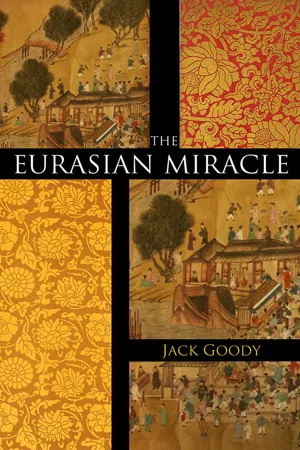The Eurasian Miracle
About this book
In this short book Jack Goody systematically dismantles this Eurocentric view of the world. He argues that we need to look, not for a European miracle, but rather for a Eurasian miracle that went back to the Urban Revolution of the Bronze Age, that affected the Near East, India and China well before Europe and that was much advanced by the adoption of writing. Under these conditions we find a long-term exchange of information between East and West, and the dominance of one followed by the dominance of the other - in other words, alternation rather than dominance. There were measures during the Renaissance in Europe that made for continuous growth, especially the secularization of learning, but it appears that the period of Western supremacy is now coming to an end and that we are about to experience a further alternation in favour of the East.
Frequently asked questions
- Essential is ideal for learners and professionals who enjoy exploring a wide range of subjects. Access the Essential Library with 800,000+ trusted titles and best-sellers across business, personal growth, and the humanities. Includes unlimited reading time and Standard Read Aloud voice.
- Complete: Perfect for advanced learners and researchers needing full, unrestricted access. Unlock 1.4M+ books across hundreds of subjects, including academic and specialized titles. The Complete Plan also includes advanced features like Premium Read Aloud and Research Assistant.
Please note we cannot support devices running on iOS 13 and Android 7 or earlier. Learn more about using the app.
Information
Table of contents
- Cover
- Title page
- Copyright page
- 1 Alternation or supremacy?
- 2 Why European and not Eurasian?
- 3 Domestic aspects of the ‘miracle’
- 4 Eurasia and the Bronze Age
- 5 Merchants and their role in alternation
- 6 Merchant wealth and puritanical asceticism
- 7 Towards a knowledge society
- 8 The temporary advantage in alternation of the post-Renaissance west
- 9 Alternation in Eurasia
- Appendix 1 Arguments of the Europeanists
- Appendix 2 Water in east and west
- References
- Index
